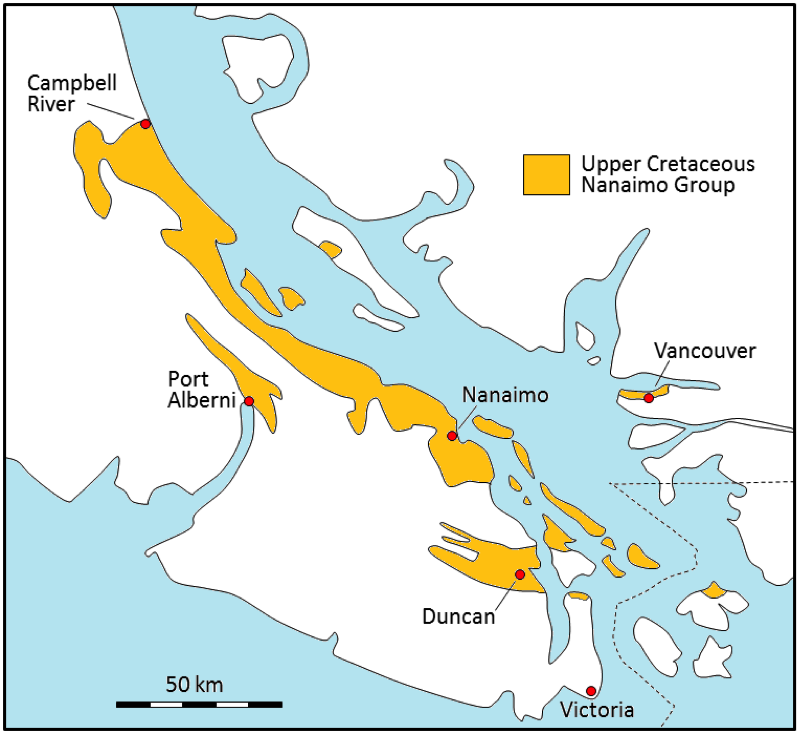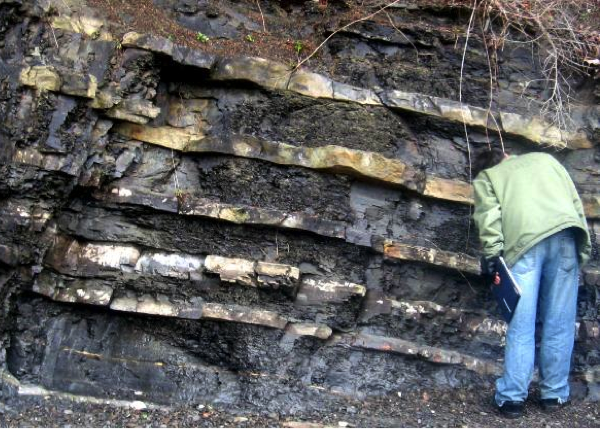9.6 Groups, Formations, and Members
Geologists who study sedimentary rocks need ways to divide them into manageable units, and they also need to give those units names so that they can easily be referred to and compared with other rocks deposited in other places. The International Commission on Stratigraphy (ICS) (http://www.stratigraphy.org/) has established a set of conventions for grouping, describing, and naming sedimentary rock units.
The main stratigraphic unit is a formation. A formation is a series of beds that is distinct from other beds above and below, and is thick enough to be shown on the geological maps that are widely used within the area in question. In most parts of the world, geological mapping is done at a relatively coarse scale, and so most formations are on the order of a few hundred metres thick. At that thickness, a typical formation would appear on a typical geological map as an area that is at least a few millimetres thick.
A series of formations can be classified together to define a group, which could be as much as a few thousand metres thick, and represents a series of rocks that were deposited within a single basin (or a series of related and adjacent basins) over millions to tens of millions of years.
In areas where detailed geological information is needed (for example, within a mining or petroleum district) a formation might be divided into members, where each member has a specific and distinctive lithology (rock type). For example, a formation that includes both shale and sandstone might be divided into members, one of which is shale, and the other sandstone. In some areas, where even more detail is required, members may be divided into beds, but this is only applicable to beds that have a special geological significance. Groups, formations, and members are typically named for the area where they are found.
The sedimentary rocks of the Nanaimo Group on Vancouver Island provide a useful example for understanding groups, formations, and members. During the latter part of the Cretaceous Period, from about 90 Ma to 65 Ma, a thick sequence of clastic rocks was deposited in a foreland basin between what is now Vancouver Island and the BC mainland (Figure 9.28). Nanaimo Group comprises a 5000 m thick sequence of conglomerate, sandstone, and mudstone layers. Coal was mined from the Nanaimo Group rocks from around 1850 to 1950 in the Nanaimo region, and is still being mined in the Campbell River area.

The Nanaimo Group is divided into 11 formations (Table 9.3). In general, the boundaries between formations are based on major lithological differences. A wide range of depositional environments existed during the accumulation of the Nanaimo Group rocks, from nearshore marine for the Comox and Haslam Formation; to fluvial and deltaic with backwater swampy environments for the coal-bearing Extension, Pender, and Protection Formations; to a deep-water submarine fan environment for the upper six formations. The differences in the depositional environments are probably a product of variations in tectonic-related uplift over time.
| Table 9.3 Nanaimo Group Formations |
|||
| Age (Ma) | Formation | Lithologies | Depositional Environmemt |
|---|---|---|---|
| ~65-66 | Gabriola | Sandstone with minor mudstone | Submarine fan, high energy |
| ~66-67 | Spray | Mudstone/ sandstone turbidites | Submarine fan, low energy |
| ~67-68 | Geoffrey | Sandstone and conglomerate | Submarine fan, high energy |
| ~68-70 | Northumberland | Mudstone turbidites | Submarine fan, low energy |
| ~70 | De Courcy | Sandstone | Submarine fan, high energy |
| ~70-72 | Cedar District | Mudstone turbidites | Submarine fan, low energy |
| ~72-75 | Protection | Sandstone and minor coal | Nearshore marine and onshore deltaic and fluvial |
| ~75-80 | Pender | Sandstone and minor coal | Nearshore marine and onshore deltaic and fluvial |
| ~80 | Extension | Conglomerate, with minor sandstone and some coal | Nearshore marine and onshore deltaic and fluvial |
| ~80-85 | Haslam | Mudstone and siltstone | Shallow marine |
| ~85-90 | Comox | Conglomerate, sandstone, mudstone (coal in the Campbell River area) | Nearshore fluvial and marine |
| Source: Steven Earle, with data from Mustard (1994) |
|||
The five lower formations of the Nanaimo Group are all exposed in the Nanaimo area, and were well studied during the coal-mining era between 1850 and 1950. With the exception of the Haslam formation, they were divided into members, because that was useful for understanding the rocks in the areas where coal was mined.
There is much variety in the Nanaimo Group rocks, and it would take hundreds of photographs to illustrate all of the different types of rocks. Nevertheless, a few representative examples are shown in Figures 9.30-9.32.



References
Mustard, P. (1994). The Upper Cretaceous Nanaimo Group, Georgia Basin. In J. Monger (Ed.), Geology and Geological Hazards of the Vancouver Region. Geological Survey of Canada Bulletin 481, 27-95.

